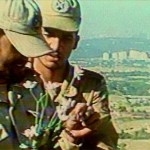Like Someone in Love
Dir. by Abbas Kiarostami
To begin: my favorite cut at TIFF. Soon after arriving at the home of a new client, a melancholic call girl makes small talk before strolling into his bedroom, undressing, crawling into bed, and falling asleep. Akiko (Rin Takanashi) appears finally to be at peace here, alone with Takashi (Tadashi Okuno), an elderly sociology professor who lives quietly with his old books, old photos, and old music. Takashi covers the young girl and lowers the lights, leaving her to her sleep. In a blinding cut, the softness of Akiko’s profile and the warm light of Takashi’s bedroom is wiped away by a trademark Kiarostami image: white clouds and blue skies in abstract motion, reflections against a car windshield. A subtle drone can be heard on the soundtrack. (Is this Kiarostami’s first-ever use of non-diegetic music?) It’s now the morning after, and Takashi is giving Akiko a ride to campus. Like magic, a whore and her John have been transformed in a blink into an anxious schoolgirl and her doting elder.
Like Someone in Love shares with Kiarostami’s previous film, Certified Copy, a fascination with the fluidity of identity and the pleasures and dangers of role-playing, particularly within relationships. Akiko adapts as best she can to the pressures of her life, shifting moment to moment from prostitute to student to girlfriend to granddaughter (both real and imagined) as each new environment demands. Takashi, likewise, steps bravely (if foolishly) into the role of grandfather and protector when called upon to do so, and the film’s most dramatic turn comes when a real-life threat shatters, quite literally, the fantasy he’d written for himself. I’m hardly the first person to point out the fun irony of the film’s title: each character performs like someone in love, miming behaviors learned from sappy songs and movie melodramas, including God-knows-how-many Japanese “fallen woman” and geisha films.
I’m beginning to think of Like Someone in Love as Kiarostami’s horror film. Blake Williams has compared it to Chantal Akerman’s Les rendez-vous d’Anna, and I think he’s right. There’s a sense in both films that deep trauma — both historical and personal — has been papered over by convention and cultural artifice, but threatens always to leak through. Akerman is more explicit about it: think of Anna’s late-night ride on a crowded train that is populated suddenly by ghosts of the Holocaust. Kiarostami works, instead, with suggestion, with vague allusions to “what happened” in the past. The final moments of the film are a shock but hardly a surprise.
Far from Vietnam (1967)
A collaborative effort between Chris Marker, Jean-Luc Godard, Alain Resnais, William Klein, Joris Ivens, Agnès Varda, and Claude Lelouch, Far from Vietnam lays out its position in the opening minutes: America’s military involvement in Vietnam is another “war of the rich waged against revolutionary struggles intended to establish governments that do not benefit the rich.” The bulk of the film then supports that argument via montage, juxtaposing footage of American jets taking off from the deck of an aircraft carrier with images of Vietnamese women building make-shift air raid shelters out of concrete. Crowds of World War II vets chant “Bomb Hanoi!” while a young man holds his child and chants “Naaaaa-palm! Naa! Naa! Naaaaa-palm!” before adding with a sigh, “Kids like this are being burned alive. Kids like this.” A television broadcast of General Westmoreland discussing the “accidents and mechanical failures” that have resulted in a few unfortunate civilian casualties is cut against footage of a mangled Vietnamese child receiving CPR.
Far from Vietnam is agit-prop. It was made as agit-prop and still reads as agit-prop (still-relevant agit-prop, unfortunately). It’s also a masterpiece. If tens of thousands of YouTube activists have co-opted the techniques of films like this, none have matched Marker’s violent cutting. The final sequence is as frenzied, exhausting, and incisive as anything I’ve ever seen. The film is also smart enough and self-aware enough to acknowledge and address the most obvious counter-arguments. “It gets complicated,” Claude Ridder says during the long, scripted monologue that is Resnais’s contribution to the film. The Ridder character plays the role of the conflicted intellectual, echoing (and complicating) a later, more biting charge from the film — that American society enjoys “the luxury of having students who protest” while slaves and farmers fight. Godard plays the role of Godard, critiquing the problems of representation and the very form of Far from Vietnam. His segment opens with a closeup of a camera lens, which in the context of the film becomes one more violent machine in a mechanized war. It’s echoed nicely by Klein’s section, a moving profile of the widow of Norman Morrison, the American Quaker whose self-immolation outside the Pentagon became a media sensation.
Far and away the best feature film I saw at TIFF. I just wish it were easier to see again. Kudos to the festival for programming this beautifully restored 35mm print.
Tower
Dir. by Kazik Radwanski
Radwanski establishes the formal rules of Tower in the opening minutes of the film and then, to his credit, follows them to the letter until the closing shot. The first image is of Derek (Derek Bogart) digging a hole in the woods. The camera is inches away from his face, where it will remain throughout the film, only occasionally panning or cutting away to the people around him. Tower takes the trademark cinematographic style of the Dardennes’ The Son to its logical extreme, performing a disarmingly intimate study of a 34-year-old man who lives in the basement of his parents’ Toronto home.
The key word there is “intimate.” Derek is an awkward, unmotivated, and self-defeating guy, but he’s socially competent. He dates someone throughout most of the film. He’s invited to parties. He has friendly, if superficial, relationships with his co-workers. The camera, in effect, gets closer to Derek than any of the people in his life do, and as a result the film emphasizes real physical proximity. Think for a minute about the number of people you touch meaningfully on any given day. A spouse or partner? A child? Films often make physical isolation a metaphor for emotional detachment; Tower is about the thing itself. Intimacy is felt profoundly in the film because it is so profoundly lacking.
Tower is in many respects a classic “first film.” It has the whiff of autobiography — Derek toils away in his bedroom on a short animated film that he’s reluctant to share with the world — and I quickly realized the film would stop rather than end (although a friend’s reading of the final sequence gives it a neater ending than I’d first assumed). Also, because it’s a kind of gimmick film (the form of it, I mean), I’m not sure what to think of Radwanski or how to predict his next move. But I’m eager to see what he does next.
Wavelengths 3
Just a quick word on Nathaniel Dorsky’s August and After, which was my favorite film at TIFF. The word I keep using to describe it is “breathe.” It breathes, and in ways that seem to mark a significant evolution in Dorsky’s recent work. The camera is moving more, and it’s moving into open spaces, even capturing portraits and ending on a long shot of a ship out at sea. For the second year in a row Dorsky’s film literally blew a fuse in the Jackman Hall projection booth, and I couldn’t have been more happy about it because it gave me a second chance to look at what might be the most beautiful filmed image I’ve ever seen. It’s a shot of a flag billowing against a dark sky, which Dorsky filmed as a reflection in a window across the street. That image alone is staggering, but it becomes downright transcendent when, miraculously, a mannequin appears from shadows behind the window. And that’s when you notice the clouds passing in front of the sun. Shadows and light. Shadows and light. It’s like all of cinema reduced to a single instant.


